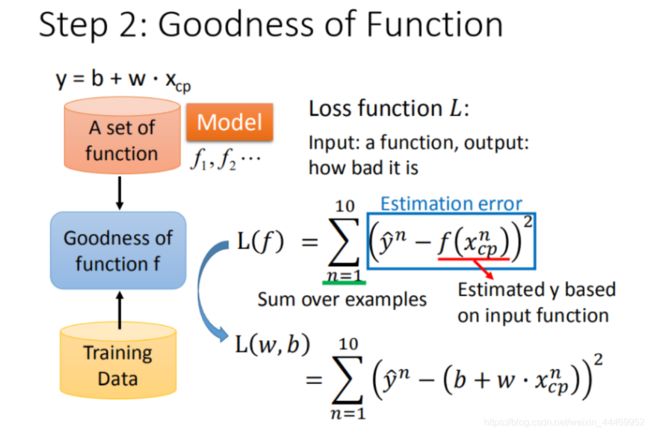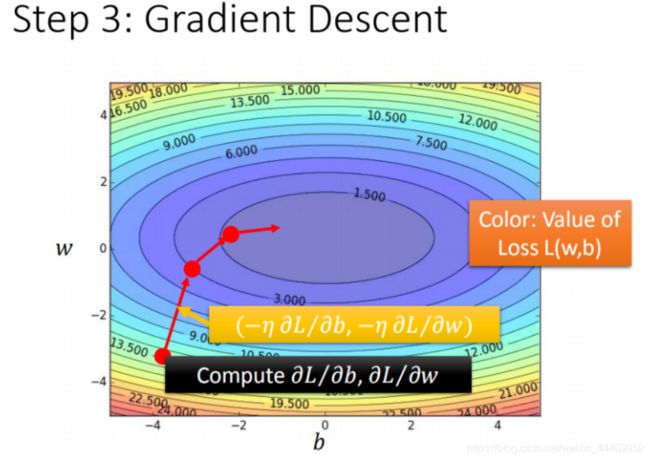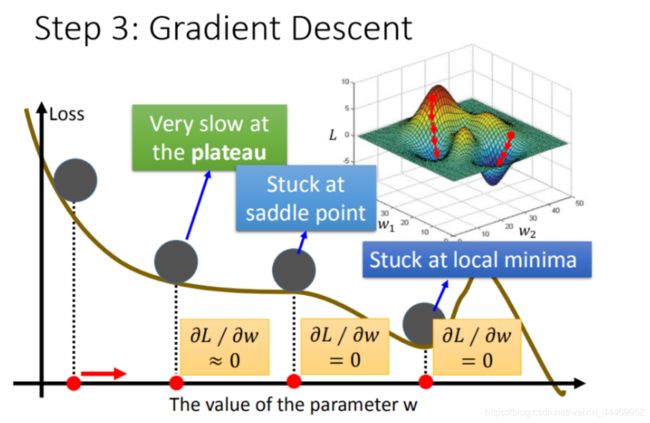李宏毅《深度学习》笔记(二)
李宏毅《深度学习》笔记(二)
这篇是关于李宏毅老师《深度学习》视频P3-P4的笔记。李宏毅老师结合宝可梦的例子讲回归,深入浅出,很适合入门学习。
一、 回归介绍
-
回归(Regression )是监督学习关于连续值最常见的方法,就是找到一个函数 functionfunction ,通过输入特征 xx,输出一个数值 Scalar。例如,股市预测(Stock market forecast);Pokemon精灵攻击力预测(Combat Power of a pokemon)。
-
结合笔记(一)介绍的建立模型(或者说寻找function)的步骤,建立模型的步骤为:
-
step1:模型假设,选择模型框架(线性模型)
根据输入特征的个数,选择训练模型。如一元线性模型, y = b + w ⋅ x c p y=b+w·x_{cp} y=b+w⋅xcp;或多元线性模型, y = b + ∑ w i ⋅ x i y=b+\sum w_i·x_i y=b+∑wi⋅xi;或一元二次回归模型等
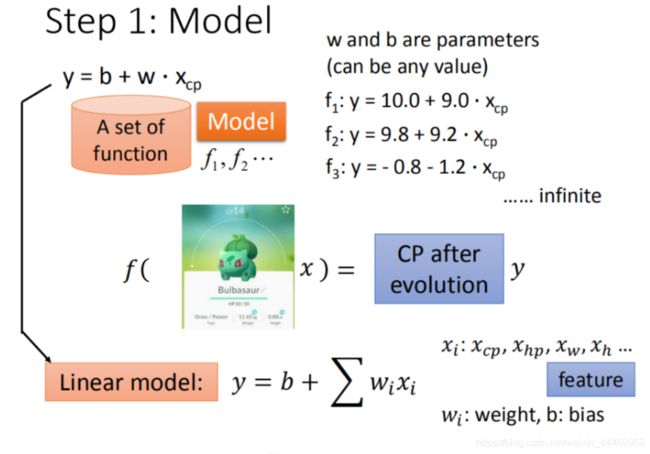
视频中用的就是宝可梦的例子,预测进化后的cp值时,可以使用许多特征:进化前的CP值、物种(Bulbasaur)、血量(HP)、重量(Weight)、高度(Height)等。
-
step2:模型评估,如何判断众多模型的好坏(损失函数)
-
step3:模型优化,如何筛选最优的模型(梯度下降)
得到损失函数后重点在求解得出b和w的值,常见的方法可以有最小二乘法(Ordinary Least Squares)、极大似然估计(Maximum Likelihood Estimate),梯度下降法(Gradient Descent)。视频里主要介绍了梯度下降法。
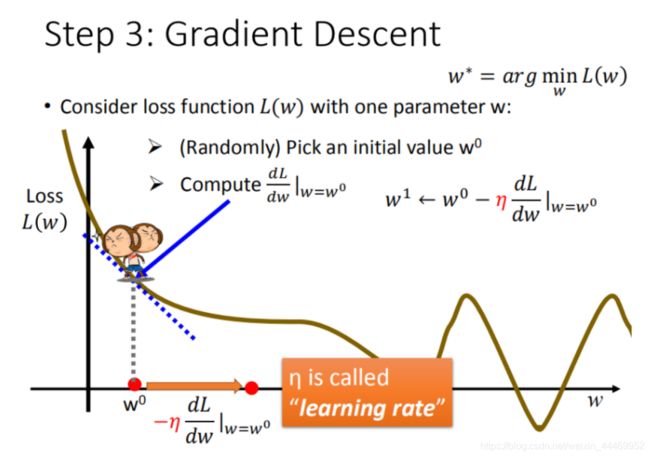
-
- 步骤1:随机选取一个 w 0 w^0 w0
- 步骤2:计算微分,也就是当前的斜率,根据斜率来判定移动的方向
- 大于0向右移动(增加w)
- 小于0向左移动(减少w)
- 步骤3:根据学习率移动
- 重复步骤2和步骤3,直到找到最低点
其中,学习率即移动的步长
吴恩达教授介绍关于学习率(Learning Rate)
https://www.youtube.com/watch?v=W0GdZchasxk&list=PLOXON7BTL9IW7Ggbc09jLqGmzkwPI4-3V&index=11
但是在梯度下降过程中,会遇到一些问题:
绘制得到的图形可能会如图这般是一个山谷形状,可能在不同的初始点会得到不同的结果,即存在局部最优的情况。在更复杂的算法中,还会出现问题2和问题3。
二、正则化
在模型优化时,增加更多的参数和变量是办法之一。但存在的一个问题就是过拟合,为了解决过拟合问题,我们可以采用正则化的方法。
正则化:正则化是结构风险最小化策略的实现,就是在损失函数(经验风险)上加一个正则化项(Regularizer)或称罚项(Penalty Term)。正则化项,一般是模型复杂度的单调递增函数,模型越复杂,正则化值就越大。
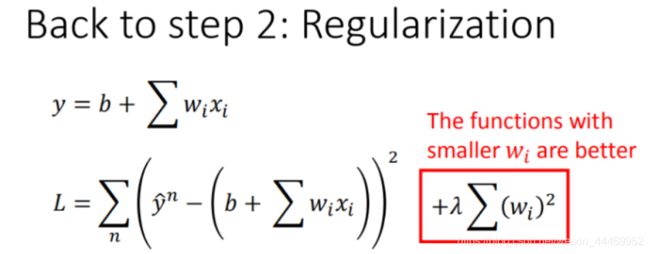
正则化项可以去不同的形式,主要可以有 L 1 L_1 L1范数: λ 2 ⋅ ∣ ∣ w ∣ ∣ 2 \frac{\lambda}{2}·||w||^2 2λ⋅∣∣w∣∣2以及L_2范数 λ ⋅ ∣ ∣ w ∣ ∣ 1 {\lambda}·||w||_1 λ⋅∣∣w∣∣1
正则化的作用就是选择经验风险与模型复杂度同时比较小的模型
三、回归与梯度下降法的代码实现
现在假设有10个x_data和y_data,x和y之间的关系是y_data=b+w*x_data。b,w都是参数,是需要学习出来的。现在我们来练习用梯度下降找到b和w。
import numpy as np
import matplotlib.pyplot as plt
from pylab import mpl # matplotlib没有中文字体,动态解决
plt.rcParams[‘font.sans-serif’] = [‘Simhei’] # 显示中文
mpl.rcParams[‘axes.unicode_minus’] = False # 解决保存图像是负号’-'显示为方块的问题
x_data = [338., 333., 328., 207., 226., 25., 179., 60., 208., 606.]
y_data = [640., 633., 619., 393., 428., 27., 193., 66., 226., 1591.]
x_d = np.asarray(x_data)
y_d = np.asarray(y_data)
x = np.arange(-200, -100, 1)
y = np.arange(-5, 5, 0.1)
Z = np.zeros((len(x), len(y)))
X, Y = np.meshgrid(x, y)
# loss
for i in range(len(x)):
for j in range(len(y)):
b = x[i]
w = y[j]
Z[j] [i] = 0 # meshgrid吐出结果:y为行,x为列
for n in range(len(x_data)):
Z[j] [i] += (y_data[n] - b - w * x_data[n]) ** 2
Z[j] [i] /= len(x_data)
先给b和w一个初始值,计算出b和w的偏微分
# linear regression
#b = -120
#w = -4
b=-2
w=0.01
lr = 0.000005
iteration = 1400000
b_history = [b]
w_history = [w]
loss_history = []
import time start = time.time()
for i in range(iteration):
m = float(len(x_d))
y_hat = w * x_d +b
loss = np.dot(y_d - y_hat, y_d - y_hat) / m
grad_b = -2.0 * np.sum(y_d - y_hat) / m
grad_w = -2.0 * np.dot(y_d - y_hat, x_d) / m
#update param
b -= lr * grad_b
w -= lr * grad_w
b_history.append(b)
w_history.append(w)
loss_history.append(loss)
if i % 10000 == 0:
print(“Step %i, w: %0.4f, b: %.4f, Loss: %.4f” % (i, w, b, loss))
end = time.time()
print(“大约需要时间:”,end-start)
# plot the figure
plt.contourf(x, y, Z, 50, alpha=0.5, cmap=plt.get_cmap(‘jet’)) # 填充等高线
plt.plot([-188.4], [2.67], ‘x’, ms=12, mew=3, color=“orange”)
plt.plot(b_history, w_history, ‘o-’, ms=3, lw=1.5, color=‘black’)
plt.xlim(-200, -100)
plt.ylim(-5, 5)
plt.xlabel(r’ b b b’)
plt.ylabel(r’ w w w’)
plt.title(“线性回归”)
plt.show()
为了避免学习率过大或过小,再给b和w特制化两种Learning rate:
# linear regression
b = -120
w = -4
lr = 1
iteration = 100000
b_history = [b]
w_history = [w]
lr_b=0
lr_w=0
import time
start = time.time()
for i in range(iteration):
b_grad=0.0
w_grad=0.0
for n in range(len(x_data)):
b_grad=b_grad-2.0*(y_data[n]-n-w*x_data[n])1.0
w_grad= w_grad-2.0*(y_data[n]-n-w*x_data[n])*x_data[n]
lr_b=lr_b+b_grad**2
lr_w=lr_w+w_grad**2
#update param
b -= lr/np.sqrt(lr_b) * b_grad
w -= lr /np.sqrt(lr_w) * w_grad
b_history.append(b)
w_history.append(w)
# plot the figure
plt.contourf(x, y, Z, 50, alpha=0.5, cmap=plt.get_cmap(‘jet’)) # 填充等高线
plt.plot([-188.4], [2.67], ‘x’, ms=12, mew=3, color=“orange”)
plt.plot(b_history, w_history, ‘o-’, ms=3, lw=1.5, color=‘black’)
plt.xlim(-200, -100) plt.ylim(-5, 5) plt.xlabel(r’ b b b’)
plt.ylabel(r’ w w w’) plt.title(“线性回归”)
plt.show()
